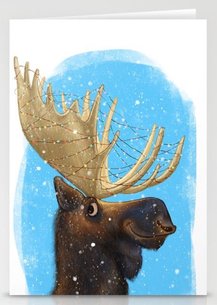That’s the summation of Daniel Gifford, assistant professor of U.S. history at George Mason University. He’s the author of “American Holiday Postcards 1905-1915: Imagery and Context.” I listened to an engrossing podcast on WBUR’s “On Point” in which he discussed the subject. Gifford explained holiday cards are like social media in two ways: they help foster connections between loved ones and they allow folks to present a version of themselves. Since the holidays arrive at the end of the year, they are an ideal opportunity to take stock of our lives and update our network on how we’ve spent the past 360-some-odd days. Holiday cards also operate like Facebook and such in that we decide what others see – we choose our most flattering photos, highlight our accomplishments, and so on. By the 1880s, Americans sent millions of holiday cards each year. The idea of reaching out to people through the mail was, according to Gifford, a “breakthrough” at the time. Louis Prang was the first American to stand out in the area of greeting card publishing – he put out his first batch of Christmas cards in 1875 and by the 1880s he issued more than five million each year. Also of note, cards have been remarkably consistent in generic messages and imagery – “Happy Holidays” coupled with a snowman, etc. Although, Gifford explained there have been slight changes from time to time. During World War II, for instance, some carried patriotic sayings. Why in this age of technology have paper greeting cards endured? The professor’s theory is people relish the tactile – they enjoy reaching into their mailbox and having something to hold. Some would argue greeting cards have taken on even greater significance in our digital world. Also, there’s some reciprocity involved – if you receive a holiday card then you feel obligated to send one in return. The old “chain letter” game.
It’s often said children are like their parents (“The apple doesn't fall far from the tree”), so it doesn’t surprise me that my parents aren't ones to send out holiday cards either. My folks might mail a few here and there, but I’ve haven’t known them to do it on a large scale. I know, however, they treasure the cards they receive. They take each piece out of the envelope and display it prominently in their home. This gets back to what Gifford mentioned about savoring a piece of physical communication.
I have a cousin who has mailed me holiday cards for a while now. I enjoy hearing of the various milestones achieved by he, his wife, and his kids – work, school, travels, etc. It’s the only contact I’ve had with him in who-knows-how-long, and now that I think of it I haven’t yet received this year's message. Perhaps he doesn’t have my latest address and his correspondence has been marked “return to sender.” Such is the nature of the activity.
0 Comments
Your comment will be posted after it is approved.
Leave a Reply. |
AuthorI'm Eli Natinsky and I'm a communication specialist. This blog explores my work and professional interests. I also delve into other topics, including media, marketing, pop culture, and technology. Archives
July 2024
Categories |


 RSS Feed
RSS Feed